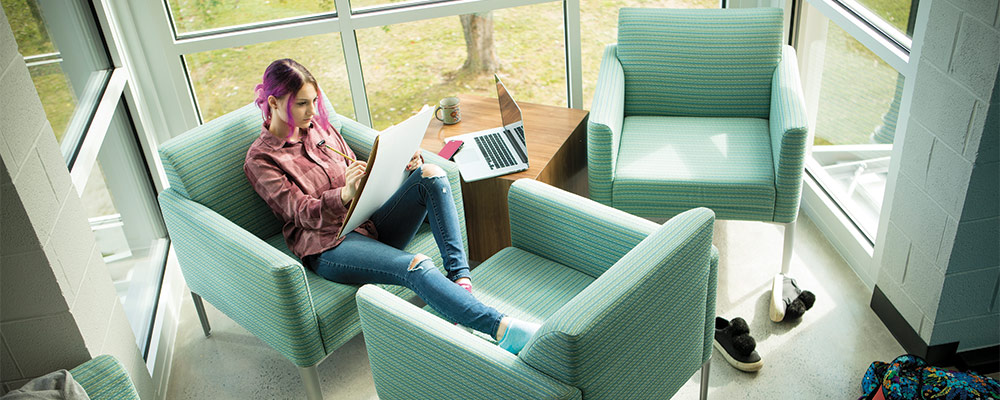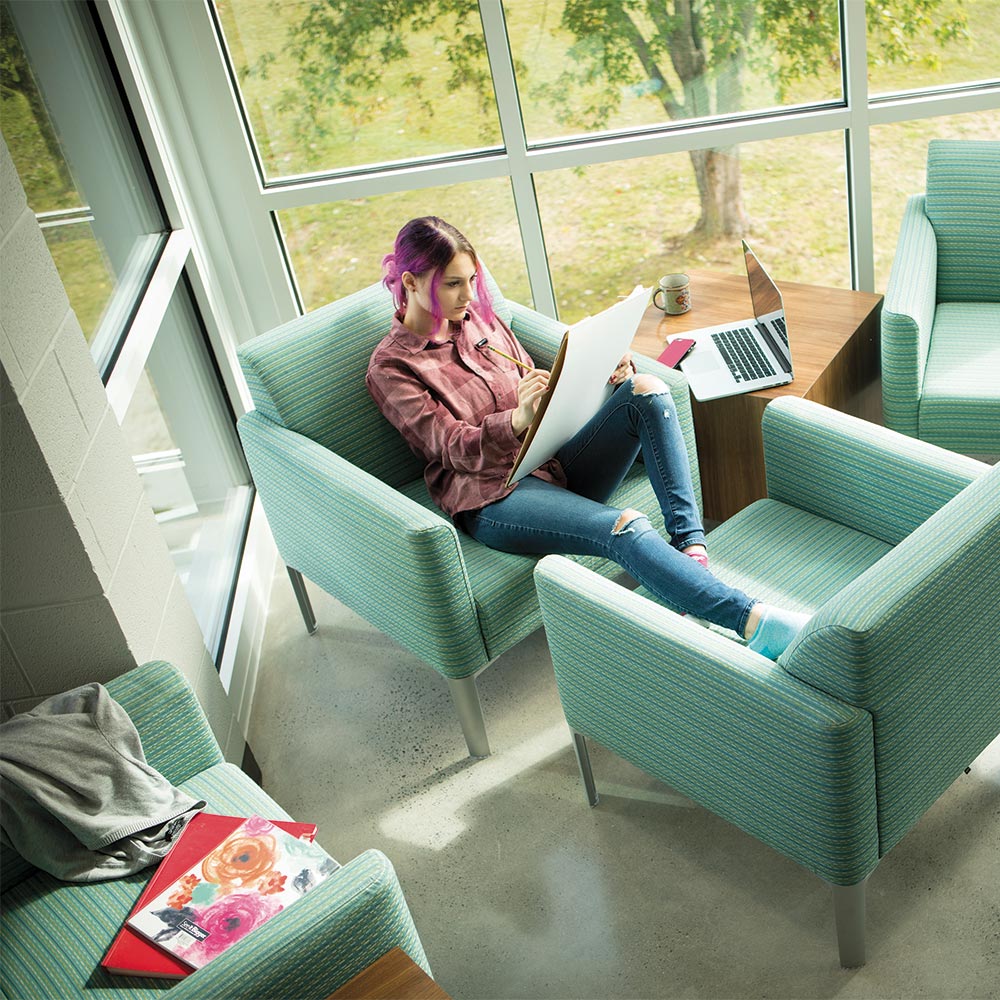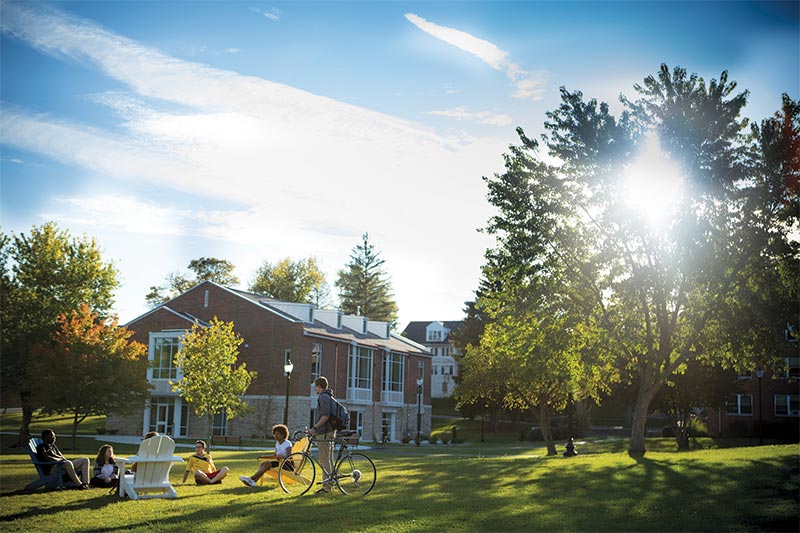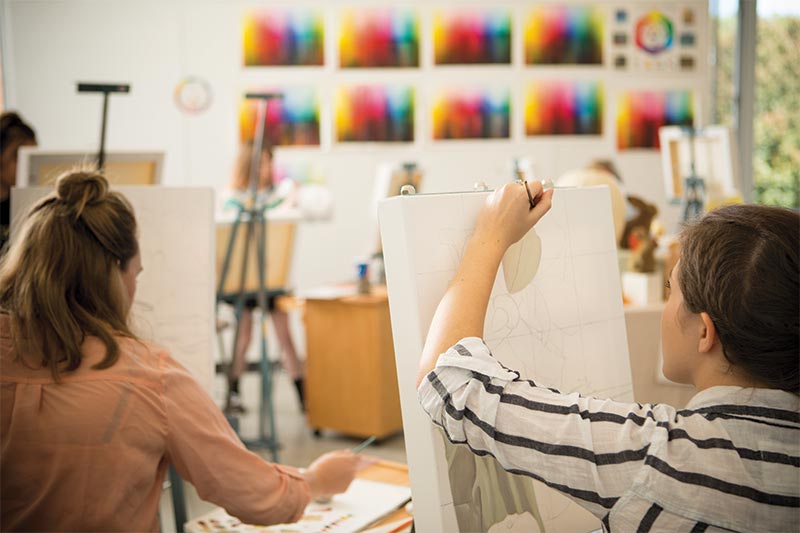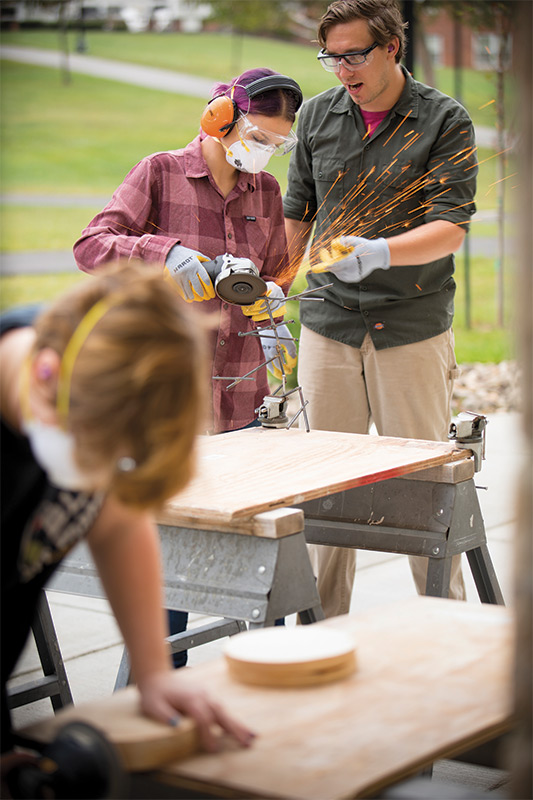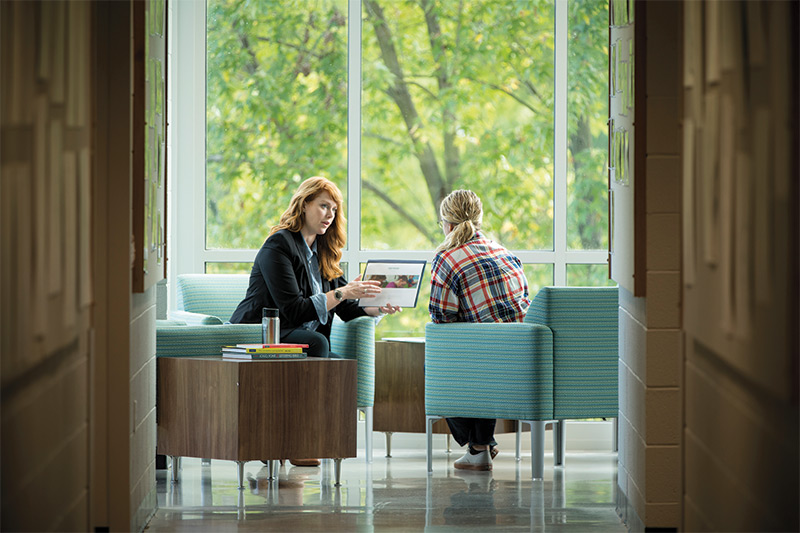“Being able to see into different classrooms and look at everyone’s artwork opens your mind to other forms of art,” Scafuro says.
Opened for the first day of classes of the fall 2017 semester, Kepple Hall is Juniata’s home for integrated media and studio arts. From digital art, graphic design, and video production to painting and sculpture, the facility is the first building on campus where students creating many forms of art can collaborate and see each other’s work displayed on a daily basis.
“In Kepple, students feel like their work is meaningful,” Scafuro says. “Here, creating art is more than getting a grade—your work can give others inspiration.”
Students like Scafuro aren’t the only ones who’ve been craving this space. The faculty teaching integrated media and studio arts at Juniata have also longed for learning spaces that push students’ creativity to the next level.
Scaling up Sculpture
Until fall 2017, students studying sculpture at Juniata had to limit their work to what could fit through a standard doorway. They used dowel rods and plaster. Now, Rob Boryk, instructor in art and art history, helps students roll welding equipment and saws through a garage door for their 9 a.m. class in Kepple Hall. With the proper safety precautions, Boryk encourages students to bend metal and cut glass.
“In Kepple, students feel like their work is meaningful. Here, creating art is more than getting a grade—your work can give others inspiration.”Chelsea Scafuro, ’18 Geneva, Ohio
“Some students have figured out how to manipulate metal to get different colors,” says Boryk. “Others have researched Native American techniques. The only parameters are that each piece of art must be a minimum of 24 inches and it must be able to come back into the studio through that same garage door, meaning that it could be a maximum size of 12 feet in each direction.”
For their final project, students must create figurative pieces based on the human form that are site specific, meaning that they must choose a location where the sculptures bring meaning to their surroundings.
To successfully complete the project, each student must get approval from the building manager where they’d like their piece displayed, which according to Boryk, “teaches that artists don’t just do what they want—they have to be conscientious about what they do and make things work.
“Many students are interested in creating figures larger than life,” Boryk says. “If I have 16 students, sculpting at life size, it feels like there are 32 students in our classroom.”
Boryk’s living, breathing students are discovering that the openness of Kepple Hall is inspiring larger-scale projects, regardless of the project in which they currently are immersed. Like much of the art created in the new building, sizeable sculptures demand to be shared outside of the building, across Juniata’s campus.
An Environment of Professionalism
When Ryan Gibboney, instructor in integrated media arts (IMA), moved into Kepple Hall, she was excited about having space where her students could set up equipment—like cameras, lights, and booms—and then allow the equipment to properly cool before they tear it down, just like a camera crew would do in a professional setting. She was also thrilled that students would have space designated for them to complete video and design projects without having to worry about whether other classes were scheduled in the same space.
But Gibboney’s work with community-engaged learning projects in her Introduction to IMA course helped her appreciate something else about Kepple Hall.
Integrated Media Arts is an interdisciplinary program that enables students to graduate as multimedia specialists by combining art, communication, information technology, and professional writing. So, in the introductory IMA course, Gibboney’s students partner with local organizations to design logos, create posters, and make websites for clients’ marketing needs. Rather than working on mock scenarios, creating products that will never be used, Juniata students contribute their work in a way that helps them realize the positive impact that they can have on their community. Kepple Hall plays a role in making that difference.
“Doing professional work in an environment that mimics a professional agency drastically improves how well students will be prepared for work.”Ryan Gibboney, instructor in integrated media arts
“We now have a more comfortable, inviting environment for meeting with community partners,” Gibboney says. “These clients are an essential way for students to work with someone who won’t give them all the answers and prompts.”
Gibboney operates her courses like a creative agency. Students are treated like professionals, they work in teams, and their community partners are considered clients. With Kepple Hall operational, the setting matches the expectations of the classes as well—and students notice it.
Shining a Light on Two-Dimensional Art
Monika Malewska, associate professor of art, teaches the College’s painting and drawing courses. She is grateful that Kepple Hall architects designed classrooms so that students could manipulate light to improve their work.
“The painting and drawing studio is facing north, which provides the specific lighting condition to do the work we do, like still life,” Malewska says. “This gives us consistent light. If the classroom faces east or west, the lighting changes dramatically.”
In addition to facing a direction where lighting is more consistent, two-layered blinds enable Malewska’s classes to customize lighting to the conditions they need. They can even direct light at a cork board area for critique.
The emphasis on light continues into Kepple Hall’s corridors, which professors use as teaching tools, displaying the best of their students’ work.
“It’s an honor for them to have their work exhibited,” Malewska adds, gesturing toward display areas that shine lights directly on surfaces designed for students’ art to hang—spaces that mimic gallery settings beyond Kepple Hall. “These are great motivational tools.”
Thanks to these displays, students pass peer work on a daily basis. In so doing, they see what other courses they can take. But one thing Malewska has learned underlines the impact of Kepple Hall: that students’ collaboration and creativity have been unleashed.
“One Friday night, about 10:30 p.m., I realized I had left something in my office, so I came back to campus,” Malewska recalls. “When I stepped in the building, I heard music. I was hoping my students were doing homework. Lo and behold, they were doing night drawing sessions.”
“One Friday night, about 10:30 p.m., I realized I had left something in my office, so I came back to campus,” Malewska recalls. “When I stepped in the building, I heard music. I was hoping my students were doing homework. Lo and behold, they were doing night drawing sessions.”Monika Malewska, associate professor of art
Bringing It All Together
“Kepple Hall is not just physically bringing everyone in the arts together, it’s bringing all the inspiration together,” Scafuro says.
From Kepple Hall, student created sculpture is exhibited in the lobby of von Liebig Center for Science. Integrated media arts students produce and direct films that premiere in Alumni Hall. In December 2017, senior Matt Gaynor’s film, A Small, Unimportant, and Beautiful Life or: (The Explanation of an Unexplained Journey Through the Multiverse), opened at Clifton 5 Cinemas in downtown Huntingdon.
Scafuro and her peers are only getting started.
“I will be applying the skills I have learned in video production in an internship next semester,” Scafuro says. “My only disappointment is that I’m not in my first year at Juniata because I can tell that Kepple Hall will always be a place to expand your creativity by blending many different fields.”
